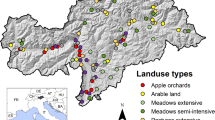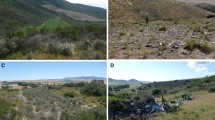Abstract
Semi-natural habitats are currently one of the most important environments for many taxa. The main aim of this study was to discover how diurnal butterflies (Lepidoptera) and flower-visiting beetles (Coleoptera) respond to the environment of traditional fruit orchards. In total, 25 orchards were studied in the rural-agricultural landscape in the Czech Republic. Both study taxa were sampled using timed survey walks in 2010. Seven variables in two environmental categories (patch and geography) were evaluated with respect to the species richness of the studied taxa using partial regression, hierarchical partitioning and generalized linear modeling of the best selected variables. Butterflies were highly influenced at a patch level. An increased number of flowering plants, as a reflection of nectar sources for adults, significantly explained a high level of variability, both alone and via interaction with other studied variables. Beetles were influenced by patch and geography to the same degree, although altitude (as a reflection of geographical heterogeneity) significantly negatively explained the highest level of variability. The results indicate that diurnal butterflies and flower-visiting beetles as insect taxa with similar habitat requirements respond differently in heterogeneous environments of traditional fruit orchards. They also indicate the need for multi-taxa studies, even in marginal ecosystems of recent landscapes.



Similar content being viewed by others
References
Benes J, Konvicka M, Dvorak J, Fric Z, Havelda Z, Pavlicko A, Vrabec V, Weidenhoffer Z (2002) Motýli České republiky: Rozšíření a ochrana I, II. SOM, Praha
Benes J, Cizek O, Dovala J, Konvicka M (2006) Intensive game keeping, coppicing and butterflies: the story of Milovicky Wood, Czech Republic. For Ecol Manag 237:353–365
Binzenhofer B, Schroder B, Strauss B, Biedermann R, Settele J (2005) Habitat models and habitat connectivity analysis for butterflies and burnet moths—the example of Zygaena carniolica and Coenonympha arcania. Biol Conserv 126:247–259
Breeze TD, Bailey AP, Balcombe KG, Potts SG (2011) Pollination services in the UK: How important are honeybees? Agric Ecosyst Environ 142:6–12
Cizek O, Zamecnik J, Tropek R, Kocarek P, Konvicka M (2012) Diversification of mowing regime increases arthropods diversity in species-poor cultural hay meadows. J Insect Conserv 16:215–226
Cizek O, Vrba P, Benes J, Hrazsky Z, Koptik J (2013) Conservation potential of abandoned military areas matches that of established reserves: plants and butterflies in the Czech Republic. PLoS One 8:e53124
Cronon W (1996) The trouble with wilderness: or, getting back to the wrong nature. Environ Hist 1:7–28
European Environment Agency (2006) CORINE land cover. http://www.eea.europa.eu/
Foottit RG, Adler PH (2009) Insect biodiversity: science and society. Blackwell, UK
GEODIS (2006) Ortofotomapa ČR. http://www.geodis.cz/
Grill A, Cleary DFG, Stettmer C, Brau M, Settele J (2008) A mowing experiment to evaluate the influence of management on the activity of host ants of Maculinea butterflies. J Insect Conserv 12:617–627
Hamback PA, Summerville KS, Steffan-Dewenter I, Krauss J, Englund G, Crist TO (2007) Habitat specialisation, body-size and phylogeny explains density area relationships in Lepidoptera: a cross-continental comparison. Proc Natl Acad Sci USA 104:8368–8373
Hegland SJ, Boeke L (2006) Relationships between the density and diversity of floral resources and flower visitor activity in a temperate grassland community. Ecol Entomol 31:532–538
Horak J (2013) Habitat requirements of conspicuous burnet moth Zygaena ephialtes (Linnaeus, 1767; Lepidoptera: Zygaenidae). North-West J Zool 9:1–5
Horak J (2014) Fragmented habitats of traditional fruit orchards are important for dead-wood dependent beetles associated with open canopy deciduous woodlands. Naturwissenschaften 101:499–504
Horak J, Chobot K, Gabris R, Jelinek J, Konvicka O, Krejcik S, Sabol O (2011) Uphill distributional shift of endangered habitat specialist. J Insect Conserv 15:743–746
Horak J, Peltanova A, Podavkova A, Safarova L, Bogusch P, Romportl D, Zasadil P (2013) Biodiversity responses to land use in traditional fruit orchards of a rural agricultural landscape. Agric Ecosyst Environ 178:71–77
Hurka K (2005) Brouci České a Slovenské republiky. Kabourek, CR
Kadlec T, Tropek R, Konvicka M (2012) Timed surveys and transect walks as comparable methods for monitoring butterflies in small plots. J Insect Conserv 16:275–280
Kawecki TJ (2008) Adaptation to marginal habitats. Annu Rev Ecol Evol Syst 39:321–342
Konvicka M, Maradova M, Benes J, Fric Z, Kepka P (2003) Uphill shifts in distribution of butterflies in the Czech Republic: effects of changing climate detected on a regional scale. Glob Ecol Biogeogr 12:403–410
Krauss J, Stefan-Dewenter I, Tscharntke T (2003) Local species immigration, extinction, and turnover of butterflies in relation to habitat area and habitat isolation. Oecologia 137:591–602
Lomolino MV (2001) Elevation gradients of species-density: historical and prospective views. Glob Ecol Biogeogr 10:3–13
McNeely JA (2002) Forest biodiversity at the ecosystem level: Where do people fit in? Unasylva 53:10–15
Noordijk J, Delille K, Schaffers AP, Sykora KV (2009) Optimizing grassland management in roadside verges for flower-visiting insects. Biol Conserv 142:2095–2103
Sjodin NE, Bengtsson J, Ekbom B (2008) The influence of grazing intensity and landscape composition on the diversity and abundance of flower-visiting insects. J Appl Ecol 45:763–772
Steffan-Dewenter I, Tscharntke T (1997) Early succession of butterfly and plant communities on set-aside fields. Oecologia 109:294–302
Steffan-Dewenter I, Tscharntke T (1999) Effects of habitat isolation on pollinator communities and seed set. Oecologia 121:432–440
Zimmermann K, Fric Z, Filipova L, Konvicka M (2005) Adult demography, dispersal and behaviour of Brenthis ino (Lepidoptera: Nymphalidae): how to be a successful wetland butterfly. Eur J Entomol 102:699–706
Acknowledgments
This study was supported by the Internal Grant Agency (IGA No. A10/14), Faculty of Forestry and Wood Sciences, Czech University of Life Sciences Prague. Mr. Besitzer corrected the English and an anonymous referee helped to improve this paper.
Author information
Authors and Affiliations
Corresponding author
Electronic supplementary material
Below is the link to the electronic supplementary material.
Rights and permissions
About this article
Cite this article
Horak, J. Insect taxa with similar habitat requirements may differ in response to the environment in heterogeneous patches of traditional fruit orchards. J Insect Conserv 18, 637–642 (2014). https://doi.org/10.1007/s10841-014-9667-z
Received:
Accepted:
Published:
Issue Date:
DOI: https://doi.org/10.1007/s10841-014-9667-z




